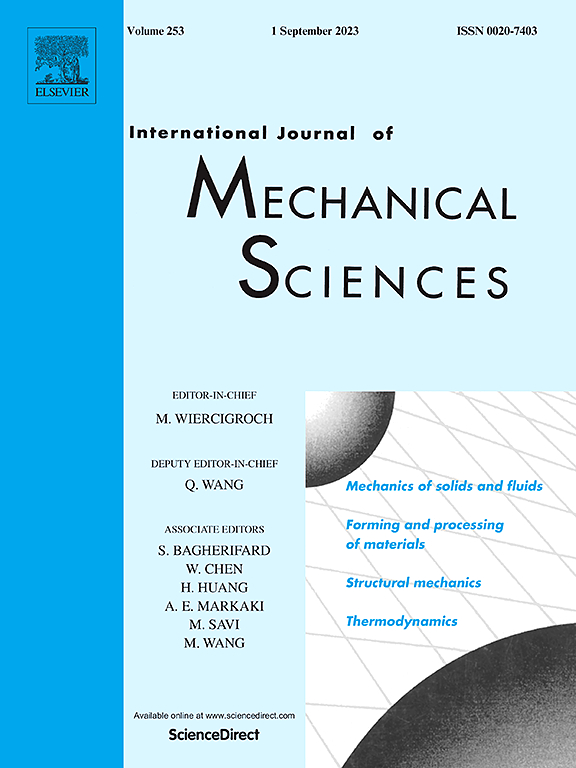自适应双稳夹持器,具有鳍射线效果,适用于多种抓取
IF 7.1
1区 工程技术
Q1 ENGINEERING, MECHANICAL
International Journal of Mechanical Sciences
Pub Date : 2025-04-14
DOI:10.1016/j.ijmecsci.2025.110279
引用次数: 0
摘要
夹持双稳性是自然界中常见的一种机制,由于其快速响应和力放大的特点,在软夹持器设计中得到了广泛的应用。然而,目前的双稳夹持器设计在实现多用途夹持任务的自适应性能方面经常面临挑战。本文提出了一种自适应双稳夹持器,该夹持器在弹簧连接双稳结构中结合了鳍射线效应和手指-手掌协同作用。在本设计中,软手指连接到双稳结构,其基础运动通过铰接连杆机构耦合到刚性双稳框架。此外,夹持器自主地将动态物体的动能转换为双稳结构内的势能,从而诱导卡断行为。通过理论分析和实验分析,对夹持器在静态和动态抓取两种情况下的非线性力学响应进行了评估。结果表明,该双稳爪具有较强的自适应能力,可通过主动触发和被动触发抓取静态和动态物体,响应时间可达数十毫秒。它还显示了多种功能,如水下和多物体抓取。这项研究有助于双稳夹持器设计的进步,并显示出具有挑战性的应用前景,如空间碎片清理,空中栖息和深海操纵。本文章由计算机程序翻译,如有差异,请以英文原文为准。

Self-adaptive bistable gripper with Fin Ray effect for versatile grasping
Snap-through bistability, a mechanism frequently observed in nature, has been extensively applied in the design of soft grippers due to its rapid response and force amplification characteristics. However, current bistable gripper designs often face challenges in achieving adaptive performance for versatile grasping tasks. This paper proposes a self-adaptive bistable gripper that incorporates the Fin Ray effect and finger–palm synergy within a spring-link bistable structure. In this design, the soft fingers are connected to the bistable structure, with their base motion coupled to the rigid bistable framework through an articulated linkage mechanism. Moreover, the gripper autonomously converts the kinetic energy of a dynamic object into potential energy within the bistable structure, inducing snap-through behavior. Theoretical and experimental analyses were conducted to evaluate the nonlinear mechanical response of the gripper during both static and dynamic grasping scenarios. The results indicate that the bistable gripper exhibits notable self-adaptive capabilities and can grasp static and dynamic objects with response times of tens of milliseconds through active and passive triggering. It also displays versatile capabilities, such as underwater and multi-object grasping. This research contributes to the advancement of bistable gripper design and shows promise for challenging applications such as space debris cleanup, aerial perching, and deep-sea manipulation.
求助全文
通过发布文献求助,成功后即可免费获取论文全文。
去求助
来源期刊

International Journal of Mechanical Sciences
工程技术-工程:机械
CiteScore
12.80
自引率
17.80%
发文量
769
审稿时长
19 days
期刊介绍:
The International Journal of Mechanical Sciences (IJMS) serves as a global platform for the publication and dissemination of original research that contributes to a deeper scientific understanding of the fundamental disciplines within mechanical, civil, and material engineering.
The primary focus of IJMS is to showcase innovative and ground-breaking work that utilizes analytical and computational modeling techniques, such as Finite Element Method (FEM), Boundary Element Method (BEM), and mesh-free methods, among others. These modeling methods are applied to diverse fields including rigid-body mechanics (e.g., dynamics, vibration, stability), structural mechanics, metal forming, advanced materials (e.g., metals, composites, cellular, smart) behavior and applications, impact mechanics, strain localization, and other nonlinear effects (e.g., large deflections, plasticity, fracture).
Additionally, IJMS covers the realms of fluid mechanics (both external and internal flows), tribology, thermodynamics, and materials processing. These subjects collectively form the core of the journal's content.
In summary, IJMS provides a prestigious platform for researchers to present their original contributions, shedding light on analytical and computational modeling methods in various areas of mechanical engineering, as well as exploring the behavior and application of advanced materials, fluid mechanics, thermodynamics, and materials processing.
 求助内容:
求助内容: 应助结果提醒方式:
应助结果提醒方式:


